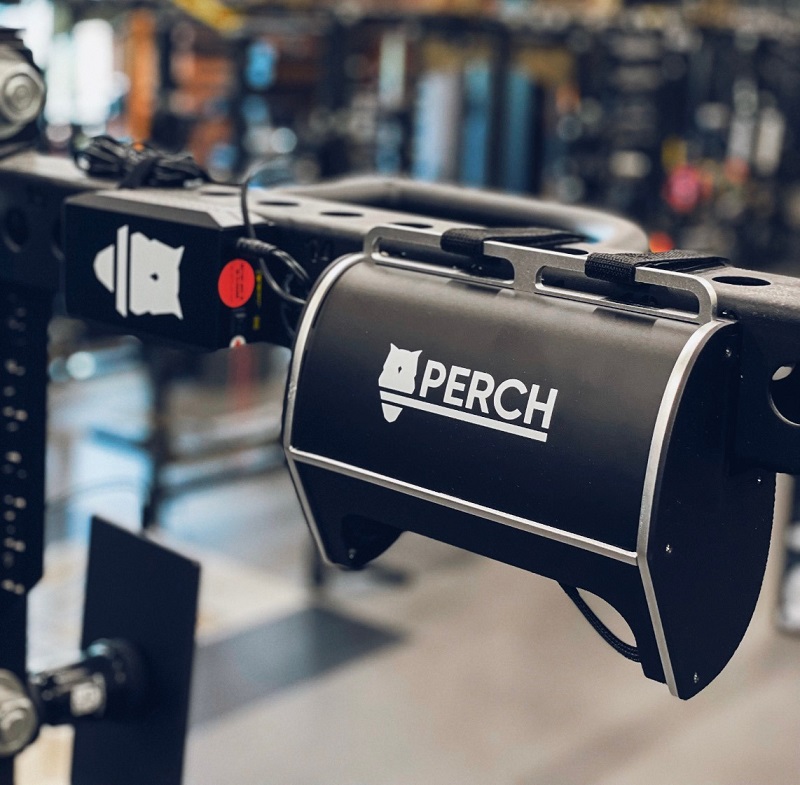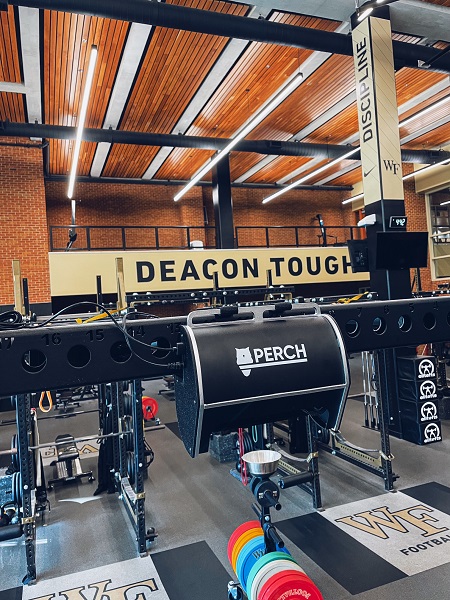Perch is Changing the Game of Velocity-Based Training

While recovering from a herniated disc injury as an MIT undergraduate student, Jacob Rothman started brainstorming ideas for a device that could help athletes track their workouts to prevent injury. Entered Perch, which, in less than five years, has changed the way athletes monitor their training.
Dubbed as an “invaluable addition” to their training program by the Orlando Magic, weight training platform Perch has pulled in a number of new users in NFL and NCAA football and basketball teams. Among those teams include the New England Patriots, Pittsburgh Steelers, Baylor Bears (Men’s Basketball), and North Carolina Tar Heels.
Perch was created by former MIT athletes Jacob Rothman, Nate Rodman, and Jordan Lucier within MIT’s hallowed machine shops with the aim of giving users the ability to monitor their weight training movements and progress via 3D cameras and a tablet. As of September 13, it was announced that Perch closed $4 million in a funding round. This brought the fitness technology company’s total raised funds thus far to $6 million since its inception in 2017. A new investor of the company is Miami Dolphins cornerback Byron Jones, who counts Perch as an integral part of his training regimen.
“Perch helps me train smarter,” Jones began in an official press release on the matter. “It enables me to see my weight room performance, my lifting speed and power, on every rep of every set, allowing me to reach my training goals without overexerting myself in an already physically demanding sport. I’m excited to see Perch continue to innovate as they revolutionize the way free lifting is measured.”
Perch continues to experience unprecedented growth.

“Today, Perch devices are popping up in more and more weight rooms across the NFL, MLB, NHL, MLS, NBA and NCAA. Some of the more prominent teams using the technology to help their players train smarter and reduce the risk of injury include the Miami Dolphins, New York Giants, Pittsburgh Steelers, Georgia Bulldogs Football, Maryland Terps Football and University of Virginia Men’s basketball, among numerous others,” co-founder Rothman tells Athletech News. “Devices have also been installed at various military bases, fitness and performance facilities, and a growing number of high schools and home gyms across the country.”
Rothman counts founding Perch as his greatest accomplishment and confidently says his company is “changing an industry.” Rothman adds, “With a team of 3 (myself and my 2 co-founders), we designed, manufactured and developed all the software needed to then market and sell a product to the 2019 College Football National Champion LSU Tigers. In 2021, with a team of six (6), we surpassed $1M in sales after only about 1.5 years of selling, half of which was during a global pandemic. I could not be more proud of my co-founders and employees.”
What truly makes Perch brilliant is its effectiveness in a simple package and use — a 3D camera and tablet are attached to a weight rack, an athlete heads over to the weight rack, logs in on the tablet, and begins their weightlifting training. That athlete’s movements are tracked by the camera while their work (sets, reps, velocity, power output) is input into the tablet. Afterwards, both athletes and their coaches can look at the data in order to better implement a consistent strategy for performance advancement.
Regarding the science and technology behind Perch, Rothman explains, “When you step into the weight room, it’s super low tech. There’s so much information that is being missed. … It’s data that is really valuable. It’s basically making a weight rack smart, that’s how we like to describe it.” Rothman says his motivation to hold Perch as a leading fitness technology brand lies in “ensuring that all athletes have the opportunity to use our devices to monitor movements during exercise and enhance their motivation, safety and performance in the weight room – something that fitness technology has to date failed to address.” Albeit, Rothman’s tireless work cuts into his sleeping schedule. He tells Athletech News he doesn’t get enough sleep, typically working “about 70 hours per week.”
But Rothman’s visionary work has paid off greatly, with professional and collegiate sports teams such as the Miami Dolphins, Philadelphia Phillies, Tennessee Titans, and Duke University Football remaining among the many to praise Perch. The United States Football League credits Perch for being the leading reason behind players’ athletic improvement. USFL Director of Sports Performance Zac Woodfin says, “Our players came in with really no offseason experience with us, but through Perch, we were able to get pretty exact with the loads and intensities we were prescribing, to make sure we were getting the effect we wanted to get in our training. Perch fundamentally changed the way our players lifted by giving them immediate data regarding their quality of movement and keeping them progressing towards our collective goals.”

Wake Forest University’s Demon Deacons have also gained a number of positive gains from Perch. Wake Forest Director of Football Sports Performance Chad Bari confirms the team’s players not only enjoy Perch’s “user-friendly interface,” but have easily gravitated towards Perch’s real-time data per its monitoring system, which in turn, allows for better preparation on the field and court.
“We use velocity-based training constantly, so for our guys to now have automatic feedback of what we want them to accomplish, and for us to be able to collect that data in real time and be able to make adjustments on the fly and maximize what they’re able to give us, is going to be a game changer,” says Bari.
With the addition of Perch in a multitude of outside and home gyms, high school, professional sports facilities, and other locations, Rothman wants to expand his business further for the benefit of more athletes. “Perch helps prepare you for game day. Looking ahead, we want to be in every professional and Power 5 and professional sports team in the country, and beyond. The main goal is not just to get Perch everywhere, but let’s get velocity-based training everywhere, and show people how valuable it is,” he declares.
For more insight from Jacob Rothman on how Perch was created, the future of fitness, and his role model, read on for these CEO Corner answers, exclusively given to Athletech News.
Athletech News (ATN): Please tell us about your current company and how either your role or the company (if you are a founder) came to fruition.
Rothman: I was an MIT undergrad and member of the school’s baseball team when I suffered a herniated disc while doing a warm-up set of squats in the weight room during the summer after my freshman year. The doctors couldn’t pinpoint exactly what caused the injury, but I was clearly not training in the right way. It could have been my form, that my body was overworked or that I wasn’t getting enough sleep. Anyone’s guess was as good as mine.
While recovering from my injury, I started to brainstorm ideas for a device that could help athletes better quantify workouts in the weight room to prevent injury and improve overall performance. Soon after, I teamed up with two other athletes on campus – Nate Rodman and Jordan Lucier – and we came up with the idea for Perch. Over the next couple of years, we spent entire nights in MIT’s machine shops building, designing and testing different prototypes.
Today, Perch devices are popping up in more and more weight rooms across the NFL, MLB, NHL, MLS, NBA and NCAA. Some of the more prominent teams using the technology to help their players train smarter and reduce the risk of injury include the Miami Dolphins, New York Giants, Pittsburgh Steelers, Georgia Bulldogs Football, Maryland Terps Football and University of Virginia Men’s basketball, among numerous others.
Devices have also been installed at various military bases, fitness and performance facilities, and a growing number of high schools and home gyms across the country.
ATN: Who is your mentor? Role model?
Rothman: Phil Knight, the dynamic iconoclast who for nearly 50 years has shod the feet of sports legends and “weekend warriors” alike. Phil’s story has many ups and downs and challenges to count – from cash flow, to competition, to legal issues – but his marketing savvy and uncompromising competitiveness has transformed the athletic-shoe industry and made Nike one of the most successful and widely recognized brand names in the world.
ATN: Where do you see the future of fitness going?
Rothman: It can be hard to keep up with the latest trends and constant changes in the fitness industry. But one thing is for sure: technology is playing an increasingly important role in the way we work out. From fitness and wellness apps that track our progress to machine learning, there’s no doubt that technology is changing the fitness landscape. I’m clearly a little biased, but the sports technology that excites me the most is pretty much anything that helps athletes better quantify workouts in the weight room to prevent injury and improve overall performance.
Candace Cordelia is a Pennsylvania-based journalist and on-camera broadcaster/host, with a reporting background in wrestling, entertainment, and lifestyle. Her reporting work has been featured on websites and in publications such as Bustle, Pro Wrestling Illustrated, New York Daily News, am New York, ABC News, Yahoo!, Good Morning America, Madame Noire, Sister 2 Sister, etonline.com, Diva Dirt and The Everyday Fan. Her favorite workout influencers include Chloe Ting, Cassey Ho, Pamela Reif and Mary Braun. She still can’t stand burpees and Rebbl Dark Chocolate Immunity Elixir is one of her favorite post-workout protein sips. You can follow Candace on Twitter @CandaceCordelia and on Instagram @thatgirlcandace16.



